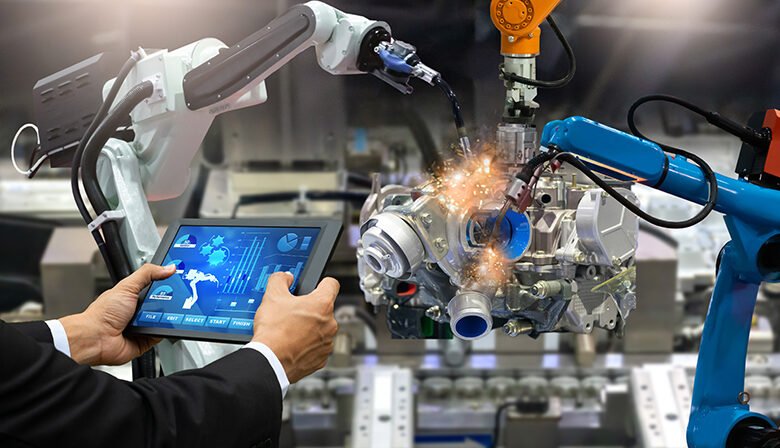
Staying ahead of the competition is essential for businesses in the rapidly evolving industrial space. Today, the integration of cutting-edge technologies has become crucial for success. As we talk about technology, hyper-automation, and Robotic Process Automation, also known as RPA, have emerged as game-changers in the manufacturing sector.
Do you also operate in manufacturing and want to take your business to new heights? If yes, applying hyperautomation in the manufacturing business is all that you need! This blog will tell you how you can revolutionize your business growth with hyperautomation and RPA. But let’s understand what it is!
What is hyperautomation?
Hyperautomation represents the seamless integration of advanced technologies. It includes new-age technologies like. Artificial intelligence (AI), machine learning (ML), robotic process automation (RPA), and intelligent business process management suites (iBPMS).
It aims to automate complex business processes end-to-end. It also streamlines the operations and enhances efficiency. Moreover, hyperautomation in manufacturing drives innovation across the value chain.
RPA in manufacturing
Robotic Process Automation (RPA) is a component of hyperautomation in manufacturing. It involves the deployment of software robots or “bots” to automate repetitive, rule-based tasks traditionally performed by humans. In the manufacturing sector, RPA finds application in many areas, ranging from inventory management and order processing to quality control and compliance.
One of the critical advantages of RPA in manufacturing is its ability to enhance operational efficiency and accuracy. By automating routine tasks such as data entry, invoice processing, and inventory tracking, RPA frees up valuable human resources to focus on more strategic initiatives.
How businesses are adopting hyperautomation?
Manufacturers worldwide are adapting hyperautomation to revolutionize their operations. With the help of data-driven insights and intelligent automation tools, businesses can optimize production processes, minimize errors, and accelerate time-to-market. From automating inventory management to predictive maintenance, hyperautomation transforms traditional manufacturing paradigms.
Where can you apply hyperautomation?
The applicability of hyperautomation in manufacturing is vast and diverse. It spans various functions such as supply chain management, production planning, quality control, and customer service. Whether automating repetitive tasks on the factory floor or streamlining complex decision-making processes, hyperautomation offers endless possibilities for optimization and growth.
How can hyperautomation boost your business?
The benefits of hyperautomation in manufacturing are manifold. Eliminating manual interventions and reducing operational bottlenecks enhances productivity and scalability.
Real-time analytics and predictive modeling empower manufacturers to make data-driven decisions, driving cost savings and improving overall agility. Moreover, hyperautomation paves the way for sustainable growth and competitive advantage by fostering innovation and fostering a culture of continuous improvement.
Here are some compelling benefits of hyperautomation in the manufacturing business:
-
Increased efficiency:
By automating repetitive tasks and streamlining workflows, hyperautomation minimizes manual interventions and reduces the likelihood of errors. This results in faster turnaround times, improved resource utilization, and enhanced operational efficiency across the manufacturing value chain.
-
Enhanced quality control:
Hyperautomation enables manufacturers to implement robust quality control mechanisms by leveraging real-time data analytics and predictive modeling. Manufacturers can ensure higher product quality and customer satisfaction by identifying and addressing potential defects or deviations early in the production process.
-
Cost savings:
By optimizing processes and reducing operational inefficiencies, hyperautomation helps manufacturers achieve significant cost savings. From reducing labor costs associated with manual tasks to minimizing waste and downtime, hyperautomation contributes to a more cost-effective and sustainable manufacturing ecosystem.
-
Greater agility and flexibility:
Hyperautomation empowers manufacturers to respond rapidly to changing market dynamics and customer demands. Manufacturers can adapt their operations swiftly to seize new opportunities and address emerging challenges by automating decision-making processes and enabling real-time insights.
-
Improved compliance and risk management:
Hyperautomation facilitates adherence to regulatory requirements and industry standards by enforcing standardized processes and documentation practices. By automating compliance-related tasks such as audit trails and reporting, manufacturers can minimize risks and ensure regulatory compliance with greater ease and efficiency.
-
Facilitates innovation:
Hyperautomation fosters a culture of innovation within manufacturing organizations by freeing up human resources to focus on strategic initiatives and creative problem-solving. By automating routine tasks, employees can devote more time and energy to value-added activities such as product development, process optimization, and research and development.
Well! After hearing all the benefits of hyper-automation and RPA in manufacturing. you must be fascinated. But let us tell you that implementing hyperautomation requires a strategic approach and specialized expertise.
It would help if you connected with professional services providers to make the best of these benefits They play a crucial role in guiding manufacturers through digital transformation. From assessing organizational readiness to designing tailored automation solutions, they offer comprehensive support at every stage of the implementation process.
Final words
Hyperautomation in manufacturing can unlock new opportunities for growth and stay ahead in today’s dynamic marketplace by adapting to these technologies. Lastly, if you wish your manufacturing business to stand out, embracing hyperautomation isn’t just an option—it’s a strategic imperative for success in the modern manufacturing ecosystem.



